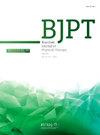阴道测压法区分孕妇盆底肌肉收缩弱与强的诊断准确性和临界点
IF 3.2
3区 医学
Q1 ORTHOPEDICS
引用次数: 0
摘要
背景识别孕妇盆底肌(PFM)收缩的强弱有助于预防和治疗妊娠晚期和产后的功能障碍。方法这是一项诊断准确性研究。44 名怀孕三个月的妇女参加了研究(平均年龄为 29±5 岁)。参考测试为阴道触诊,指标测试为阴道测压(Peritron™ 压力计)。阴道测压法评估的变量包括静息、最大自主收缩(MVC)、MVC 平均值、持续时间、坡度、曲线下面积(AUCm)和收缩速度。结果观察到,MCV 峰值(临界值:40.56 cmH2O)具有区分孕妇 PFM 收缩弱/强的完美鉴别力(AUC=1.00)。MVC 平均值显示出卓越的区分能力(AUC=0.96;临界值:30.66 cmH2O)。结论 使用阴道测压法区分孕妇 PFM 收缩弱/强的最佳变量是 MVC 峰值、MVC 平均值、梯度和 AUCm。本文章由计算机程序翻译,如有差异,请以英文原文为准。
Diagnostic accuracy and cut-off points for vaginal manometry to differentiate between weak and strong pelvic floor muscle contraction in pregnant women
Background
Identifying a weak/strong pelvic floor muscle (PFM) contraction in pregnant women may help prevent and treat dysfunctions during late pregnancy and postpartum.
Objective
To determine whether the Peritron™ manometer can accurately differentiate a weak from a strong PFM contraction and the respective cut-offs for its variables in pregnant women.
Methods
This is a diagnostic accuracy study. Forty-four women in the third trimester of pregnancy participated (mean±SD age: 29±5 years). The reference test was vaginal palpation, and the index test was vaginal manometry (Peritron™ manometer). Variables assessed by vaginal manometry were rest, maximal voluntary contraction (MVC), MVC average, duration, gradient, area under the curve (AUCm), and contraction speed. The Receiver Operating Curve (AUC/ROC) was used to analyze the data and obtain cut-off points for these variables.
Results
Perfect discrimination (AUC=1.00) to differentiate between a weak/strong PFM contraction in pregnant women was observed for peak MCV (cut-off: 40.56 cmH2O). The MVC average showed excellent discriminative ability (AUC=0.96; cut-off: 30.66 cmH2O). The gradient variable (AUC=0.85; cut-off: 27.83 cmH2O/s) and AUCm (AUC=0.86; cut-off: 1315.6 cm²*s) showed a good discriminative ability.
Conclusion
The best variables to discriminate between weak/strong PFM contraction in pregnant women using vaginal manometry were peak MVC, MVC average, gradient, and AUCm.
求助全文
通过发布文献求助,成功后即可免费获取论文全文。
去求助
来源期刊
CiteScore
6.10
自引率
8.80%
发文量
53
审稿时长
74 days
期刊介绍:
The Brazilian Journal of Physical Therapy (BJPT) is the official publication of the Brazilian Society of Physical Therapy Research and Graduate Studies (ABRAPG-Ft). It publishes original research articles on topics related to the areas of physical therapy and rehabilitation sciences, including clinical, basic or applied studies on the assessment, prevention, and treatment of movement disorders.

 求助内容:
求助内容: 应助结果提醒方式:
应助结果提醒方式:


